
Among the 16th Century wealthy, there began to appear collections of significant objects known as a wunderkammern or “chambers of wonders”. Now they are more commonly referred to as cabinets of curiosities. Such cupboards were filled with assemblages of objects bearing some particular significance for the owner. Occasionally a wunderkammer might occupy an entire room. Most often, the objects contained within these collections were focused upon natural history: skins, bones, bird nests, fossils for example. Rocks and minerals and artifacts from primitive societies were often collected as well. Within other collections, works of art might be found among the grouping of valued items. The objects on display were often collected during voyages of exploration, trade, or conquest. This is why, in the beginning, wunderkammern were the province of merchants, aristocrats, and royalty. Eventually these collections became popular among the more general population. During the Victorian Era it was especially common for homes to feature a cabinet of curiosities. Why?
Psychologist Christian Jarrett notes that, Humans are unique in the way we collect items purely for the satisfaction of seeking and owning them. He observes that multiple hypotheses have been offered as reasons for our inclination to collect. Everything from being unloved as a child to providing an enhanced ability to attract potential mates has been postulated by behaviorists. Whatever the reason just think of the plethora of collections people still amass here in the 21st Century. Sports memorabilia, coins, stamps, old farm tractors, field guides to birds, classic cars, trading cards; the list could go on and on. Yes, we humans really are inveterate collectors.
Of course I have my own ideas as to why we do this. Among the folks living during the beginnings of the cabinet of curiosities fad, collected items offered glimpses of unseen worlds. Our planet was a much bigger place then. The average person living in the late 1800’s was likely exposed to less information during their entire lifetime than one would get today from a single issue of a large, daily newspaper. Surely a morning spent browsing the Internet would do so. The objects in a cabinet of curiosities brought unexplored places, strange people, and bizarre animals to familiarity. A room or cabinet filled with unusual objects carried home the strangeness and variety to be found in the far corners of the world.
As you may have guessed, I have my own cabinet. Indeed, I have tried to imitate those bygone times and enlarge it to fill a room in our house. But, 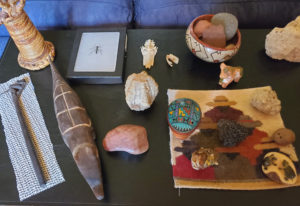 alas, my ever-indulgent wife does have her limits. Nevertheless my cabinet of curiosities is ample enough to indulge my penchant for collecting natural history objects. The “why” of my own assemblage is this. By merely casting my eyes upon a given object in my collection, I am removed from the present and transported back to another time and place. Selecting an object from my cabinet, turning it in my hand, feeling its shape and texture are the switches which turn on my meditations upon past explorations and experiences. The objects in my cabinet are the keys which open a treasure trove of remembrances. I am granted once again the wonders of the rainforests, deserts, high mountains, oceans, and extraordinary peoples of the earth. Let me give you examples.
alas, my ever-indulgent wife does have her limits. Nevertheless my cabinet of curiosities is ample enough to indulge my penchant for collecting natural history objects. The “why” of my own assemblage is this. By merely casting my eyes upon a given object in my collection, I am removed from the present and transported back to another time and place. Selecting an object from my cabinet, turning it in my hand, feeling its shape and texture are the switches which turn on my meditations upon past explorations and experiences. The objects in my cabinet are the keys which open a treasure trove of remembrances. I am granted once again the wonders of the rainforests, deserts, high mountains, oceans, and extraordinary peoples of the earth. Let me give you examples.
Upon my curiosity table sits an indigenous pottered bowl and in it rests a small gathering of stones. I lift one, a dark gray piece of granite worn smooth by the action of flowing water. It looks like a perfect stone for skipping I muse. But, as I hold this small stone, my mind effortlessly 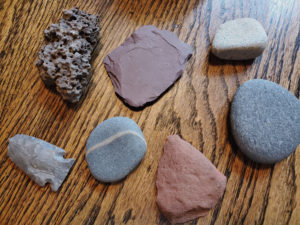 returns to the upper reaches of the Rio Napo in Ecuador where it was gathered. Shallow, flowing swiftly, strewn with boulders; the Napo looks quite different here than it does in northeastern Peru. Here, near its union with the Amazon, the river is as broad as the Ohio. Silt-laden and the color of a latte, the Napo moves at a more ponderous pace but still carries a volume of water of immense proportions. Now my mind flits to a night spent searching for caimans along the Napo’s banks. Darkness had fallen, our search was concluded, and we roared downstream toward our lodge. The anticipation of a meal of dorado, black beans and rice with a rich flan dessert urged us onward. Sitting in the bow of the boat, I was suddenly pelted by huge dollops of rain as we entered an unexpected rain squall. Racing through the pitch black night, I briefly reflected upon what might happen should we encounter a huge, undetected, floating log. After all, we had seen many caimans. And yet I recall a feeling of pure bliss and a broad smile upon my face engendered by the adventure, the remoteness, the powerful sensation of being alive in an extraordinary moment. By some mysterious navigational cleverness, our boatman suddenly veered across the ink-dark, featureless to my eyes, river and entered the unmarked channel to the lodge. We were safely home. All of this from the touching of a small piece of granite.
returns to the upper reaches of the Rio Napo in Ecuador where it was gathered. Shallow, flowing swiftly, strewn with boulders; the Napo looks quite different here than it does in northeastern Peru. Here, near its union with the Amazon, the river is as broad as the Ohio. Silt-laden and the color of a latte, the Napo moves at a more ponderous pace but still carries a volume of water of immense proportions. Now my mind flits to a night spent searching for caimans along the Napo’s banks. Darkness had fallen, our search was concluded, and we roared downstream toward our lodge. The anticipation of a meal of dorado, black beans and rice with a rich flan dessert urged us onward. Sitting in the bow of the boat, I was suddenly pelted by huge dollops of rain as we entered an unexpected rain squall. Racing through the pitch black night, I briefly reflected upon what might happen should we encounter a huge, undetected, floating log. After all, we had seen many caimans. And yet I recall a feeling of pure bliss and a broad smile upon my face engendered by the adventure, the remoteness, the powerful sensation of being alive in an extraordinary moment. By some mysterious navigational cleverness, our boatman suddenly veered across the ink-dark, featureless to my eyes, river and entered the unmarked channel to the lodge. We were safely home. All of this from the touching of a small piece of granite.
Another stone, which intrigues me greatly, rests within my collection. This one too is granite but its color is a wonderfully rich pinkish-red. I plucked it, and a few of its mates, from the sands of New Mexico many years ago.  This rock is even more highly polished than the one from the Rio Napo but the edges retain many of their irregular angles. Although mine was not, such stones are often found in association with fossilized dinosaur bones. They often lie in what would once have been the great reptiles’ abdominal cavity. This stone is a gastrolith (gastro=stomach; lithos = stone). Gravels such as this were picked up and swallowed by herbivorous dinosaurs. They were used as grist to help the stomach grind the heavy vegetation in their diet. Gastroliths have been polished not in a rock-tumbling machine but within the stomach of a sauropod. As I run my fingers over the incredibly smooth surface, I try to divine what beast may have used it; Brontosaurus, Camarasaurus or Alamosaurus perhaps? What was the environment like then? What companions shared the landscape? How did the creature that harbored these stones die? How long ago did the stone in my hand tumble and bang against others within the gizzard of a living dinosaur? One hundred million years is a possibility. This is a big number, well over a million average human life spans. Though I try mightily, my mind struggles to grasp the essence of this span of time. Nevertheless, take this gastrolith in one’s hands and it is impossible to forego meditations upon the Age of Dinsosaurs.
This rock is even more highly polished than the one from the Rio Napo but the edges retain many of their irregular angles. Although mine was not, such stones are often found in association with fossilized dinosaur bones. They often lie in what would once have been the great reptiles’ abdominal cavity. This stone is a gastrolith (gastro=stomach; lithos = stone). Gravels such as this were picked up and swallowed by herbivorous dinosaurs. They were used as grist to help the stomach grind the heavy vegetation in their diet. Gastroliths have been polished not in a rock-tumbling machine but within the stomach of a sauropod. As I run my fingers over the incredibly smooth surface, I try to divine what beast may have used it; Brontosaurus, Camarasaurus or Alamosaurus perhaps? What was the environment like then? What companions shared the landscape? How did the creature that harbored these stones die? How long ago did the stone in my hand tumble and bang against others within the gizzard of a living dinosaur? One hundred million years is a possibility. This is a big number, well over a million average human life spans. Though I try mightily, my mind struggles to grasp the essence of this span of time. Nevertheless, take this gastrolith in one’s hands and it is impossible to forego meditations upon the Age of Dinsosaurs.
There is a bobcat skull in my cabinet. I’ve long been fascinated by the skeletal anatomy of animals, especially their skulls. The cranial architecture captivates me. The perfection of their species-specific symmetry amazes me. The detailed layout of the myriad passageways through the bone which accommodate nerves and blood vessels is intriguing. My specimen catalog says my bobcat was legally collected in SW Texas in April of 1971. Already
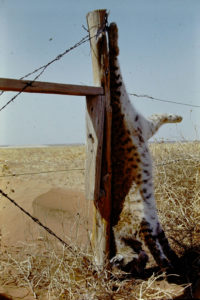
deceased, the bobcat was strung up on a fence post along a lonely backcountry road. Along the way, the fence posts were adorned with the bodies of many coyotes. Under each was a little pile of bones showing that these posts had been used for such purpose before. Down this way most folks don’t cotton to predators. Thus the macabre spectacle arranged for the enjoyment of passing motorists. And this opens a whole can of wiggling worms for me to sort through. Sometimes musing upon my curiosities evokes emotions of disquiet. Not all is warm and sunny.
I understand that the land upon which my bobcat prowled was ranchland. A 1988 Texas A&M University publication listed the annual economic loss of sheep and goats in the state due to predators at $12 million. The main culprit cited was the coyote but bobcats, foxes, and raptors are typically no more popular than the wild dog. I get it; feeling benevolent toward predators is difficult when they are causing economic loss. But must every predatory mammal encountered be killed? Must they be displayed in such a grotesque manner, one which clearly serves to demonstrate only hatred and contempt?
I like to hunt myself and have enjoyed many a meal of wild game. But even after the passage of nearly fifty years, I have been unable to erase the site of

that bobcat and all those dead coyotes strung up along the fenceline. There is something about it that just feels exceedingly wrong. Predator control directed toward an active livestock killer is one thing. Wantonly killing every coyote, bobcat, or fox one encounters is something entirely different. Heedlessly and disturbingly displaying their carcasses shows a total disconnect. It is a complete detachment from any appreciation of the innate beauty of the animal, appreciation of the ecological niche it once occupied, or its deep-time evolutionary history. It should also be noted that this practice seems a poor way to enlist public sympathy for hunting, a sport already suffering a historical decline. Such wanton destruction seems a far cry from the empathy, understanding, and gratitude the genuine sportsman-hunter  displays toward their prey. It bears little resemblance to the honorable rules of game pursuit my grandfather taught me as a neophyte hunter many decades ago. Has the noble tradition of the hunt nowadays metamorphosed into a simple lust for killing? The rise of predator hunting competitions is a case in point. The online investigative magazine FairWarning recently published an article entitled Killing Coyotes, Bobcats and Foxes for Fun and Profit. Take a look, but be forewarned. You’ll see what I mean.
displays toward their prey. It bears little resemblance to the honorable rules of game pursuit my grandfather taught me as a neophyte hunter many decades ago. Has the noble tradition of the hunt nowadays metamorphosed into a simple lust for killing? The rise of predator hunting competitions is a case in point. The online investigative magazine FairWarning recently published an article entitled Killing Coyotes, Bobcats and Foxes for Fun and Profit. Take a look, but be forewarned. You’ll see what I mean.
Also in my cabinet of curiosities is a kibuyu; a long, reddish brown gourd. This one still radiates the odor of smoke from a cooking fire. The fire in  question burned upon the dirt floor of the home of the Maasai man from whom the gourd was acquired. He used this kibuyu to hold milk, cattle blood or more often a mixture of the two, a main source of protein for the Maasai. Admiring the gourd, my mind drifts back to the savannah of East Africa and the small village of dark, smoke-filled huts with their outer walls of cow dung plaster. Viewed from afar, the village melted into the grasslands as easily as two clouds might merge. There is much to admire about the Maasai, I muse. Confirming one’s place among the morani (warrior) clan by killing a lion with a spear sounds a fairly daunting task to me. Not a fraternity for the timid I’d say. The Maasai also impressed me with their ability to maintain ancestral traditions while accommodating changes attendant to the modern world.
question burned upon the dirt floor of the home of the Maasai man from whom the gourd was acquired. He used this kibuyu to hold milk, cattle blood or more often a mixture of the two, a main source of protein for the Maasai. Admiring the gourd, my mind drifts back to the savannah of East Africa and the small village of dark, smoke-filled huts with their outer walls of cow dung plaster. Viewed from afar, the village melted into the grasslands as easily as two clouds might merge. There is much to admire about the Maasai, I muse. Confirming one’s place among the morani (warrior) clan by killing a lion with a spear sounds a fairly daunting task to me. Not a fraternity for the timid I’d say. The Maasai also impressed me with their ability to maintain ancestral traditions while accommodating changes attendant to the modern world.
But drinking milk mixed with bovine blood? The practice serves to remind me how varied and strange (at least to American minds) the eating habits of other peoples can be. My Temuan friends in SE Asia relished a meal of leaf monkey roasted over an open fire. The Penan people on adjacent Borneo included snakes, frogs, and locusts in their diet. In Indonesia, we were once served a side dish of fried blood; tasty and rich in protein but unfamiliarly unnerving on first sight. Yagua people in Peru much enjoy an alcoholic
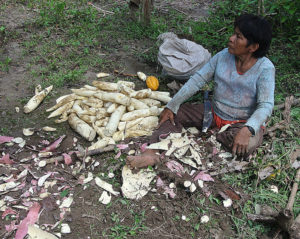
drink called chicha which is made from yuca root (or corn) and is sometimes called masato. The root is pulverized and then chewed by the women making the concoction. The masticated pulp containing their salivary enzymes is spit into a bowl, water is added, and the mixture is left to ferment before drinking. Would you give it a try? In Ecuador and Peru a dish handed down from the Incans called cuy is still

savored. But in the U.S., we more typically enjoy guinea pigs as pets, not dinner. I suppose we could find as many strange food predilections as there are foreign cultures. It is an interesting and sometimes macabre (by our standards) custom to investigate. Again, my assortment of curiosities has launched me upon remembered journeys.
There is a fossilized shark tooth in my cabinet of curiosities; as there should be for anyone interested in fossils I should think. This particular tooth came
from the Cooper River in South Carolina. It is a very big tooth from an especially large shark called megalodon. Wikipedia says, it is “regarded as one of the largest and most powerful predators to have ever lived.”
Estimates of its length range up to sixty feet and its weight more than fifty tons. Should we ever develop a time machine, it makes a swim in the Pliocene seas in which megalodon swam sound like a 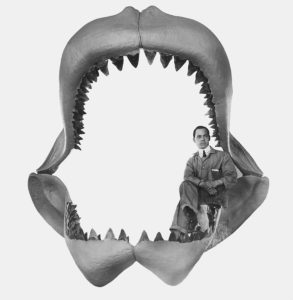 particularly bad idea. Considering the tooth often prompts me to recall my first experience of meeting a shark in the water. While snorkeling along the surface of the bathtub-warm South China Sea, a shark swam directly beneath me. It seemed to be on a mission as it swam rapidly and seemingly purposefully away. I recall my reaction as being the classic autonomic nervous system’s fight or flight response. My heartrate surged, breathing sped up, pupils dilated, and body hair stood on end. As it swam away, “my shark” miraculously, before my very eyes, shrank from the twelve-foot monster I initially perceived to a youngster a couple of feet in length. That’s what swimming with a shark for the first time can do I suppose.
particularly bad idea. Considering the tooth often prompts me to recall my first experience of meeting a shark in the water. While snorkeling along the surface of the bathtub-warm South China Sea, a shark swam directly beneath me. It seemed to be on a mission as it swam rapidly and seemingly purposefully away. I recall my reaction as being the classic autonomic nervous system’s fight or flight response. My heartrate surged, breathing sped up, pupils dilated, and body hair stood on end. As it swam away, “my shark” miraculously, before my very eyes, shrank from the twelve-foot monster I initially perceived to a youngster a couple of feet in length. That’s what swimming with a shark for the first time can do I suppose.
I have a Balinese fright mask. It is a fearsome thing with mad, bulging eyes

and lethal-looking fangs of great length. The image projected is nightmarish. Oddly enough, I find that gazing upon this fearsome disguise causes my mind to take flight and reminiscence upon one of the most pleasant sojourns of my life. I recall the island of Bali as being near paradisiacal. Granted, forty-five years have passed since I walked the sands of Kuta Beach or watched the sun set with vibrant, multicolor into the Indian Ocean to the west. Like many a paradise

the solitude and beauty of this place has been lost. When we come to love a place, it is often loved to death I’m afraid. But it is my good fortune to remember Bali without the crowds, the trendy shops, and the littered beaches. It was a place of great beauty, lovely people, and rich culture. Admiring my mask enables me to go back there.
The tropical evening brings with it an ambiance that is a splendor to behold. Absent the intense, nearly unbearable heat of midday, comes a time of picture-perfect temperature, pleasantly moist humidity, and gentle sea breeze. Anne, daughter Michelle, and I venture forth from our tiny room; $3US a day, breakfast of tea and fried banana included. First, a meal; what will it be this evening? Perhaps nasi goring (fried rice), a SE Asian staple. Satay is always a delicious choice, the skewered pieces of chicken mouthwateringly roasted over charcoal. Maybe it will be something really special such as babi guling (roast suckling pig). After dinner, comes the much anticipated, nightly visit to a Balinese theater. We sit in the open air and the beautiful, melodic tones of the gamelan orchestra begin (https://www.youtube.com/watch?v=UEWCCSuHsuQ). The metallophones, gongs, drums, and flutes emit their wonderfully exotic tones. The musicians play for hours with perfect timing 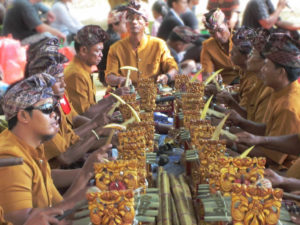 and exceptional skill. Without reference to written score or note, they rely solely on practice and memory. The dancers appear and we sit mesmerized by the artistry, skill, and mythology of a culture fourteen centuries in age. The stage is populated by kings and demons, monkey gods, and golden deer as the rich mythology of the Balinese plays out before us.
and exceptional skill. Without reference to written score or note, they rely solely on practice and memory. The dancers appear and we sit mesmerized by the artistry, skill, and mythology of a culture fourteen centuries in age. The stage is populated by kings and demons, monkey gods, and golden deer as the rich mythology of the Balinese plays out before us.
The mask of which I have spoken is a prop in such a production. This one is called the Barong-kris dance. In this mythological epic, the Barong 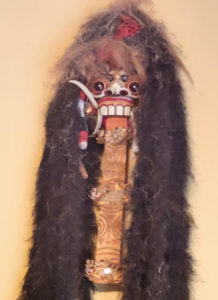 represents the king of spirits, a protective force. Aligned against Barong is the witch Rangda, evil likeness to his overpowering virtuousness. The pair battle; Rangda causes the allies of Barong to turn their krises (knives) upon themselves. Entranced by the power of Rangda one of the dancers falls upon us as he fights against her influence. We recoil in
represents the king of spirits, a protective force. Aligned against Barong is the witch Rangda, evil likeness to his overpowering virtuousness. The pair battle; Rangda causes the allies of Barong to turn their krises (knives) upon themselves. Entranced by the power of Rangda one of the dancers falls upon us as he fights against her influence. We recoil in  alarm as we try to keep the knife-wielding dancer at arm’s length. But the power of Barong is great, the demons are assuaged. Rangda is defeated. The krises are withdrawn. As with so many of the world’s mythologies, good triumphs over evil.
alarm as we try to keep the knife-wielding dancer at arm’s length. But the power of Barong is great, the demons are assuaged. Rangda is defeated. The krises are withdrawn. As with so many of the world’s mythologies, good triumphs over evil.
On other nights, we enjoyed the Hindu epic called the Ramayana and the mesmerizing kechak dance. During the day, we explored the wood carving, painting, and weaving skills of the wonderfully artistic Balinese. Other days were spent walking the beaches, some with black sand from the pulverized  volcanic rocks of the island. There were duck shepherds and padi harvesters with whom to talk. There were Hindu temples and volcanic peaks which needed exploring. I am taken back to a time when we reveled in the freedom of youthfulness. Unencumbered, naively traveling without fear, oblivious to the cares of the world we followed our bliss.
volcanic rocks of the island. There were duck shepherds and padi harvesters with whom to talk. There were Hindu temples and volcanic peaks which needed exploring. I am taken back to a time when we reveled in the freedom of youthfulness. Unencumbered, naively traveling without fear, oblivious to the cares of the world we followed our bliss.
And so, you see my friends, there are countless vistas to be offered within one’s cabinet of curiosities. I hope you too are building such a cabinet. It is never too late to start. Life is short, our experiences preciously ephemeral. But it is our great fortune that they may, with a gentle nudge from an item in our cabinet, be reenacted again and again.
Photo Credits:
cabinet of curiosities by Saudade7 @ English Wikipedia.org
cuy by Pedro Martinez Corada @ commons.wikimedia.org
fox carcasses courtesy FairWarning.org
gamelan orchestra by David Stanley @ commons.wikimedia.org
megalodon jaws @ commons.wikimeida.org
yuca root by Dick Culbert Gibsons @ commons.wikimedia.org
All others by the author.
